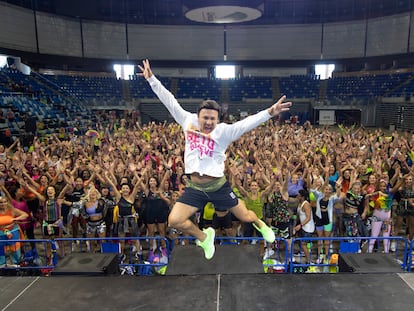Cassandro, the effeminate ‘luchador’ who triumphed in the world of Mexican wrestling: ‘Being born gay was a blessing’
Saúl Armendáriz — who spent more than three decades in the world of ‘lucha libre’ — overcame discrimination, addiction, and a stroke to see his story brought to the big screen. In a new film, he is played by acclaimed Mexican actor Gael García Bernal
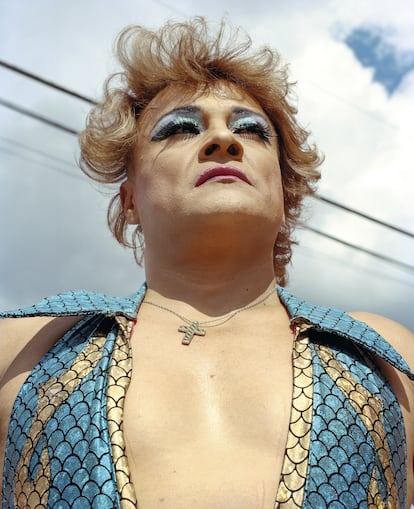

They called him every slur they could think of: “sicko,” “whore” and “degenerate.” They punched him and sprinkled green chilli on his back while he trained; they harassed and intimidated him, until he nearly committed suicide. But still, he persevered. He fought hard for more than two decades — against rivals, media detractors and prejudiced fans — until he eventually caused a profoundly transformative impact in a centuries-old discipline. On the podcast of a good friend, fellow wrestler Colt Cabana, he expressed how he felt good about “inspiring homosexual youth around the world.”
Saúl Armendáriz grew up between El Paso and Ciudad Juárez, with one foot on each side of the border that separates the United States from Mexico — two different universes, two mental constellations. From Monday to Friday, he went to his American public school, where he was bullied by many of his classmates for being small, effeminate and dark-skinned. And, on the weekend — according to a 2014 interview that he gave to William Finnegan of The New Yorker — he crossed the Paso del Norte international bridge with his sisters to enter Mexico, their homeland. The land of quesadillas, piñatas and wrestling. In the semi-clandestine arenas of the Juárez neighborhoods — where the famous cockfights were also held — the boy with two passports peered into the peculiar (and popular) world of professional wrestlers: lucha libre.
In the profile he wrote, Finnegan imagines the young Armendáriz as having been subjected to multiple stimuli that inflamed his imagination: the “enthusiastic and boisterous” public, the colorful masks, the unlikely constellation of mestizo and proletarian superheroes, the intricate traditions inherited from Greco-Latin wrestling, the piledrives and the spectacular papier-mâché.
Returning to El Paso after the Sunday break in the neighborhood rings, Saúl dealt with a mother who was exhausted from her long days as a domestic worker, as well as a father — a truck driver by profession and a stubborn sexist — who reproached his son again and again about his apparent lack of macho qualities.
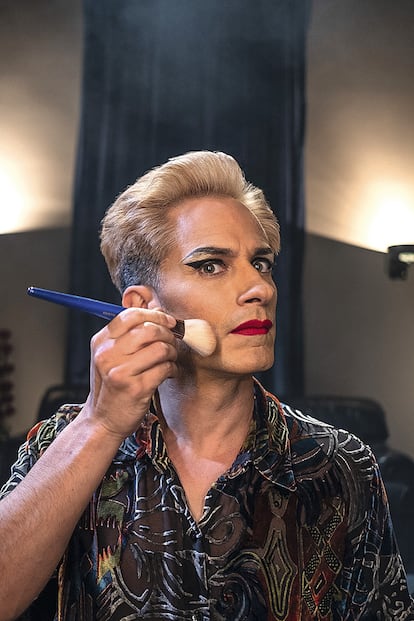
As he has noted on several occasions, Arméndáriz suffered from the animosity and contempt of his peers and family members, who treated him as “a sex toy and punching bag.” At the age of 15, he decided to turn his back on such a depressing universe, to try his luck as a wrestler in Ciudad Juárez, the place that he truly loved. “I’m not a victim,” he told The New Yorker, decades later, after he retired. “I’ve been the master of my own life. Today, I realize that being born gay was a blessing from heaven.”
From the arena to the movie theater
This story is told in Cassandro: a film dedicated to the life and work of Saúl Armendáriz. It premiered on Prime Video this past Friday, following a successful run in movie theaters. Directed by African-American filmmaker Roger Ross Williams — who won the 2009 Academy Award for Best Documentary (Short Subject) — it stars acclaimed Mexican actor Gael García Bernal, who, in addition to playing Armendáriz, is also the project’s executive director.
Both Williams and García Bernal know how to recognize a good story when it crosses their path. And that of Cassandro, the Liberace of Mexican wrestling — the man who shook the foundations of the discipline that he loves with fervor, but from which he felt excluded — had all the ingredients of a magnificent contemporary epic. Williams met Armendáriz while filming a documentary about his life, The Man Without a Mask. He was impressed by “his spirit and his joy.” He found in him “an aura, a light” that became increasingly evident as they shared tequilas in the same El Paso bars that the former fighter had frequented as a teenager.
That night, during a relaxed chat after a day of filming, the director decided that he would dedicate his first fiction film to Cassandro. The project — hampered by initial problems with financing, the pandemic, and the insane temperatures recorded in the Chihuahuan desert, where they filmed — has been a somewhat slow burn. But, in the end, it crystallized as a film that Williams describes as being “an emotional roller coaster that makes you laugh and cry.”
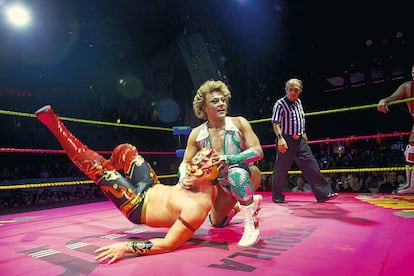
In the cast, there are special appearances by Hijo del Santo — an illustrious wrestler and former rival of Cassandro — and Bad Bunny. During filming, the Puerto Rican musician and performer revealed that he has been “a wrestling fan since he was little” and called it “one of the most relevant and influential forms of entertainment in the world.”
Two years ago, as one of his agents explains to EL PAÍS, Saúl Armendáriz had a stroke. His recovery process is proving slow, thus explaining why he rarely gives interviews. Despite everything, however, the former fighter agreed to answer a short questionnaire via email, with the condition that the questions be “simple” and that we be patient if the answers take awhile.
After a couple of days, the man — who was once known as Cassandro — responds to the virtual interview by telling us that he feels “very honored” by the interest that his story is generating. “I never thought they would make a film about me. Seeing my story on screen has been very exciting.”
Armendáriz briefly goes over the development of the project and his relationships with Roger Ross Williams and his team. “They came to El Paso a couple of times before filming. They were very good to me. I had the opportunity to meet Gael by video call. He told me that he was a little intimidated that I was going to see him fight, but he was very kind. Then, we sometimes met in person during the filming, with the rest of the team.” Looking back on his career, he nostalgically remembers certain details, “such as the recognition and respect” that they showed him “in France and other European countries,” where he worked during the final stretch of his career.
Armendáriz has no regrets. “Not only did I become a champion in my discipline, but I had a long career. I trained constantly and fought with dignity until the last fight.” He believes that the cornerstone of his legacy was “entering a macho world and aspiring to reach the highest level, while getting respect.” He assures that he has “plans” for the immediate future, but that his priority right now is “to continue recovering his health.”
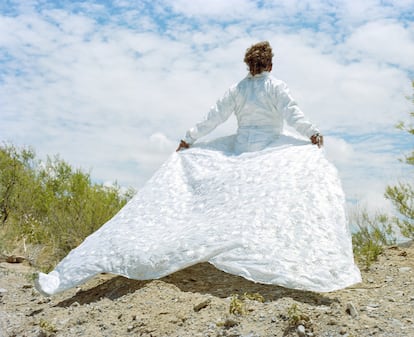
In statements made before the Hollywood screenwriters’ strike (which the Mexican performer supports), Gael García Bernal affirms that “Cassandro’s life, the magnificent costumes and the world of wrestling in general” were his main motivations for embarking on the project. “I think it’s the story of a man who searches for his own identity and turns that search into the driving force of his life.” In a certain sense, he adds, it’s also a story of border identities. “How to live and what happens in places like Juárez, which straddle two worlds [...] Juárez is neither Mexico nor the United States — it’s different from both. It’s a fascinating place, I’m passionate about it. I really like the people who grew up there.”
Armendáriz had a slow journey towards the light, from the harassment he experienced in Texas in the mid-1980s, to becoming the Olympus of the ring. Mexican wrestling, or lucha libre — a semi-sport that, in reality, is also a circus and an artistic spectacle in which every blow is made according to an agreed-upon script — has a rigid distribution of roles.
On the one hand, there are the technicians: heroes of impeccable gallantry, like leading men in a drama or a ranchero comedy. On the other hand, there are the rude ones: operetta villains, prone to boasting and dirty play. A third vertex is that of the exotics — that is, partially transvestite or feminized secondary actors, who are proposed as comic alternatives to the archetype of exaggerated virility that dominates in the fight. Saúl — who initially wanted to be a coach — tried his luck as a tough guy, but ended up becoming one of the most famous and influential exotics in history.
The character that he debuted as at the age of 17 — Mister Romano — was a tough guy with hardly any subtlety. He was inspired by Rey Misterio, a true legend who Armendáriz had the opportunity to train with on occasion. Depressed by the limited impact of his first fights in the border arenas, the young fighter accepted a suggestion made by Baby Sharon — also gay — and threw himself into the ring as an exotic. He did this for the first time in Ciudad Juárez, under an explosive identity: Rosa Salvaje, or Savage Rose. He competed barefaced, while wearing a female swimsuit, after appearing in the ring covered in makeup. He also wore a floral blouse that he rescued from his mother’s attic, and a quinceañera dress that had belonged to one of his sisters.
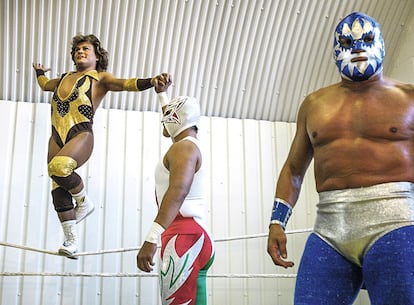
The character caused a sensation, due to his amusing audacity. Saúl — as a talented stylist with notable athletic qualities — was capable of navigating naturally between performing and competing. But, despite everything, in 1989, his first year as Rosa Salvaje, the panic over the AIDS virus resulted in homophobic attitudes. Some of the most prestigious fighters refused to face the man in the flowery blouse. He was hence relegated to a minor circuit, where he battled another talented exotic: Scarlet Pimpernel. Eventually, Wild Rose gave way to Cassandro — a toned down, somewhat less controversial and frivolous version of the same character. And it was Cassandro who finally managed to break the wall and carve out a place for himself among the elite luchadores.
A rocky path
But great stories, even those of improbable redemption and success against all odds, often have dramatic turning points. There are moments of supreme darkness that precede the first light of dawn. In Saúl’s case, this moment happened on January 28, 1991. On this day, succumbing to the pressure, he slashed his wrists with a razor blade. Scarlet Pimpernel found his almost-inert body in the bathroom.
Cassandro — in Finnegan’s words — “had just turned 21, had settled in Mexico City and had earned the trust of the country’s main promoters.” The culmination of four years of effort was a match with Hijo del Santo [The Son of the Saint], “the most popular wrestler in Mexico,” the man who had inherited the silver mask from his father, El Santo — a revered god of wrestling. But the duel was treated with disdain by many fans and reporters. For some, it was heresy to pit the heir of a glorious lineage — the man who gave dignity to an entire cultural and sporting tradition that was often reviled — against a vulgar exotic, who they saw as a homosexual freak, who didn’t deserve to be taken seriously.
The reaction left Cassandro dismayed. At the end of a path of effort and hardship, he stumbled again, upon the same old prejudiced hostility. Hence his radical attempt to throw in the towel. But, despite everything — just a week after the attempted suicide — the exotic arrived, with his wrists bandaged, to fight against the legend. He lost — something that ultimately depends on the public’s wishes and the will of the promoters. But he did so with unusual dignity, exhibiting his refined technique and the firmness of his commitment to the fight. He put on an excellent show, which helped cement his prestige.
In the following years, Cassandro often fought while drunk, increasingly dependent on drugs such as cocaine, as the deep wounds caused by disdain slowly healed. And yet, his last years as an active professional were exemplary, in the opinion of Madrid-born Rodrigo Rod Zayas, a comic book artist and former luchador. “He found a way to not let his character devour him. He became — in addition to being a magnificent fighter — a highly-respected figure on and off the circuit, a beloved veteran whom I was lucky enough to meet in person when he came to fight in Madrid in 2009. That night, he was by far the best.”
Shortly after this exhibition, Zayas took a train with Cassandro to London, to attend a meeting between professionals organized by a mutual friend: “By then, I was already more familiar with his story, with the suicide attempt, the ordeal that he had experienced in his first years in Mexico and his character as a pioneer, the exotic who broke an invisible barrier and questioned the homophobic traditions of his surroundings.”
Zayas specifies that, despite appearances, “the world of wrestling — although it’s largely based on a stereotypical vision of virility — is much more inclusive and gay-friendly than other sports, like soccer.” There’s even an LGBTQ+ circuit, “with events like the Big Gay Brunch.” Trans wrestlers abound and “the public finds it natural.” Perhaps the exception is the other global power in this discipline, Japan, “where the taste for the bizarre coexists with conservative inertia.” Another exception was Mexico in the last years of the 20th century, “precisely the environment that Cassandro contributed so much to modifying with his perseverance and example.”
Zayas defines wrestling — both Mexican and international wrestling, as well as the rest of the somewhat comparable variants — as “an artistic activity with a strong athletic component.” To succeed in such an environment, Cassandro had “unbeatable” qualities. “He had charisma, an original stage persona, a suggestive narrative and a high level of professionalism and skill that made him one of the favorites among the segment of the public that values quality above pure spectacle.”
For Zayas, Cassandro seems to be an eloquent example “of the richness of wrestling as a means of expression.” His career highlighted the affinity between wrestling and drag, “two activities in which — with all the nuances that separate one from the other — it’s about creating a personal and esthetic identity and bringing it to a competitive fantasy environment. The logic of the mask and costume is taken to a very creative dimension.”
Cassandro is certainly the epitome of the fighter who fought openly and who ended up finding an optimal balance between his personality and his character. He played the game well, claiming the dignity worthy of an exotic — the secondary, the peripheral and the diverse. A filmworthy life indeed.
Sign up for our weekly newsletter to get more English-language news coverage from EL PAÍS USA Edition
Tu suscripción se está usando en otro dispositivo
¿Quieres añadir otro usuario a tu suscripción?
Si continúas leyendo en este dispositivo, no se podrá leer en el otro.
FlechaTu suscripción se está usando en otro dispositivo y solo puedes acceder a EL PAÍS desde un dispositivo a la vez.
Si quieres compartir tu cuenta, cambia tu suscripción a la modalidad Premium, así podrás añadir otro usuario. Cada uno accederá con su propia cuenta de email, lo que os permitirá personalizar vuestra experiencia en EL PAÍS.
¿Tienes una suscripción de empresa? Accede aquí para contratar más cuentas.
En el caso de no saber quién está usando tu cuenta, te recomendamos cambiar tu contraseña aquí.
Si decides continuar compartiendo tu cuenta, este mensaje se mostrará en tu dispositivo y en el de la otra persona que está usando tu cuenta de forma indefinida, afectando a tu experiencia de lectura. Puedes consultar aquí los términos y condiciones de la suscripción digital.
More information
Archived In
Últimas noticias
Welcome to the post-religion era: The idea of Christianity as the absolute truth has become obsolete
‘I thought you would like it’: The risky sexual practice popularized by TV shows and TikTok
The digitalization of tourism: ‘They promise experiences and gave us the worst possible one’
Mexican peso defies uncertainty with forecasts of a new period of stability in 2026
Most viewed
- Sinaloa Cartel war is taking its toll on Los Chapitos
- Oona Chaplin: ‘I told James Cameron that I was living in a treehouse and starting a permaculture project with a friend’
- Reinhard Genzel, Nobel laureate in physics: ‘One-minute videos will never give you the truth’
- Why the price of coffee has skyrocketed: from Brazilian plantations to specialty coffee houses
- Silver prices are going crazy: This is what’s fueling the rally
